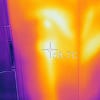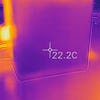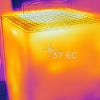Xbox Series X thermal and power analysis: how efficient is next-gen?
Good news - not just for Microsoft but for AMD too.
UPDATE: For the authoritative take on Microsoft's new flagship console, Digital Foundry's full Xbox Series X review is now live.
When the Xbox Series X form factor was first revealed at The Game Awards in December 2019, the size and shape of the unit was something of a surprise. In delivering what it believes to be the most powerful console of the next generation, Microsoft rewrote the rule book, producing a mini-tower like design aimed at maximising both performance and cooling. Has this decision paid off? With press units in the hands of journalists, stories began to appear suggesting that the console could get very hot. So, just how hot does it get and how much electricity does Series X draw from the mains? The answers are surprising - in a positive way!
With the final preview embargo up, I can share some more of my overall thoughts about the machine. I've already talked about the excellent backwards compatibility features, and what kind of storage solution is best for running your old Xbox titles on Series X, but now I can share more. Starting with the industrial design, there is a quiet revolution in design here, with the emphasis on the word 'quiet'. Series X is quiet to the point where breaking out the noise meter is a pointless exercise because the console's acoustics merge into the background noise of my living room and office. It's essentially on par with Xbox One X - and perhaps even better - which I'd rate as the current gold standard in console design. Series X is more power-hungry, but the revised form factor ensures that noise is simply not an issue.
The size and shape of the box is quite different, but still very console-like. It's basically the same height as One X, but somewhat portlier in certain dimensions. You can rest the machine vertically or horizontally and in terms of footprint, I think vertical is the way to go. Hot air rises by its very nature, so there may well be a slight cooling advantage in doing so too. In an entirely unscientific way, it certainly 'looks' better, in my opinion.
The current restrictions on the Series X preview preclude us from talking much about the dashboard (which may change by launch) but suffice to say, it's basically identical to the recent front-end upgrade for all Xbox One consoles, and if you're happy with performance on Xbox One X, it's better still on the new console. Access to a huge leap in CPU and storage performance does delivers a nigh-on lag-free experience. It's been noted that the UI is 1080p - and it caps out at 60fps, even if your console is set to 120Hz output. Series X is a 4K console and a sub-native interface does take away a touch from the quality of the presentation - sub-native games aren't really that much of an issue in the age of temporal super-sampling, AI upscaling and dynamic resolution scaling, but almost all titles deliver a native UI, simply because scaling of these elements doesn't look great. The same extends to the Xbox UI, which I'd hope to see improve over time - right now, Microsoft's focus is on delivering as much useable memory to developers as possible.
One final note before we move on to power and thermals - yes, Xbox Series X provides 802GB of useable storage on its internal SSD, up against 781GB of space on Xbox One X's 1TB HDD. Previously, I speculated that the system used compression to achieve this, possibly using the hardware decompression engines in the SoC. Microsoft informs me that the dash is optimised for Series X and uses the Zen 2 CPU cluster itself for decompression, reserving the hardware blocks for the games. Regardless, delivering more space to users and delivering the Quick Resume cache is an impressive achievement - and the 1TB Seagate expansion card doesn't need to house the OS at all, meaning 920GB of useable space.
Beyond that, it's about the software and right now, we don't have much of it. We've covered Dirt 5 and Yakuza: Like a Dragon and we'll be sharing more soon on Gears Tactics and Gears 5, but for the purposes of this piece, I really wanted to get to grips with how powerful and efficient the new wave of consoles may be. We have more silicon logic than ever before married to much higher clocks and on paper, it's a recipe for a hot, loud machine. The good news is that this is not the case. In fact, efficiency is highly impressive with much lower power consumption than I expected.
Yakuza: Like a Dragon in its 1440p60 default 'normal' mode draws between 140 to 160 watts with very rare spikes over 170W - which sees Xbox Series X drawing about as much power as Xbox One X. Codemasters' Dirt 5 has a higher overall power requirement, mostly in 160W territory, but it can spike to over 170W. I actually tried all three performance modes in the preview code for the new racer and got broadly similar results, even with 120Hz output. These results are much lower than expected and raises the question: why revolutionise console design with a much larger form factor and some seriously impressive internals if you're drawing the same level of power as Xbox One X?

| Power Consumption | Xbox Series X | Xbox One X |
|---|---|---|
| Power Off | 0-2W | 0.5W |
| Dashboard | 42W | 48.5W |
| Rise of the Tomb Raider (Peak) | 151W | 170W |
| Dead or Alive 6 (Peak) | 165W | 177W |
A look at The Coalition's Gears 5 answers the question. The Smart Delivery system delivers a revamped version of the game that draws upon the new capabilities of the system. Yes, it may be a 'patch' to an existing game, but it does leverage the new RDNA 2 architecture and its various features, including variable rate shading. In a game like Gears 5 that's built to scale, the increased load on the system is much higher and I noted power draw routinely over 200W and peaking at 211W. You can trust the Coalition to take an early lead in pushing new console hardware further.
This is a good result for a launch title and I suspect that as the generation matures, we'll see utilisation of the system increase - and more of the capacity of the 315W power supply may well be required. However, in the here and now with Gears 5, we have a great test case for analysing thermals, so I found a scene that kept the console drawing north of 200W and broke out the thermal camera - where I found an interesting distribution of temperatures across the skin of the new Microsoft console.
You can see that the metal sandwich core of processor and southbridge boards are the centre of heat and a 48-49c skin temperature on the console is the result: it feels warm to the touch but not hot. The bottom of the unit actually feels cold to the touch, especially around the mostly dormant optical drive, which is essentially at room temperature. The unit is designed to funnel in cool air from the base, take it through the console, then propel it out of the top - and that's where you find the ultimate heat centre for the console, lighting up in spectacular style on the thermal camera. Here, I noted a maximum of 62c - hotter than any console I've tested before, which is not surprising as this is the most powerful console I've tested. Put your hand above the console and you can feel the heat escape. In common with any console really, you do need to ensure that hot air can escape, so keeping Series X in an enclosed space is not a good idea.
You can definitely feel the heat escape but I'm sure the reports of using Series X to 'heat your flat' are tongue-in-cheek observations because we can tell from the watt meter that our peak power consumption is around 210 watts. There's an incremental increase in heat output compared to Xbox One X, but what we're seeing here is nothing compared to something like a high-end PC - an RTX 3080 will easily pull 320W from the mains without factoring in the rest of the PC it is attached too. And as for the 1TB Seagate storage card getting uncomfortably hot, I tested this by copying data on and off the card for 20 minutes and noted a warm-to-the-touch maximum of 49c - again, nothing to worry about. Transfer times also remained consistent, meaning that the card was not overheating to the point where performance throttled.
My ultimate conclusion is that Series X is a larger than average console, but still very much a console - and its extra size and innovative design are there to handle higher power demands than prior console generations. Crucially, the design pays off. Series X is to all intents and purposes silent and excess heat generation is successfully dealt with. Heat dissipation does require somewhere for the heat to escape to though - that much is obvious - so don't keep Series X or indeed any modern console in an enclosed space.
Going back to power consumption, the table above outlines the basics. In terms of peak power load, the Xbox One X comparisons are fascinating - in a like-for-like cutscene test at 4K30 in Rise of the Tomb Raider, Series X is clearly more efficient than Xbox One X, as you would expect. However, Dead or Alive 6 is the revelation: it's delivering up to double the performance and it still draws less power than the older console. Impressive stuff. I also noted that in instant resume 'standby' mode, the Series X still draws around 29W - enough for me to turn my machine off completely.
I think there's one further takeaway here, which is that Xbox Series X at its heaviest load is delivering performance that has been likened to an RTX 2080 and it's doing that with the additional overhead of the Zen 2 CPU cluster at a maximum load of just 211W based on the titles we have available to look at so far. This sets the stage quite nicely for the new RX 6000 GPUs from AMD, which are rumoured to deliver up to 80 compute units running north of 2GHz - up against Series X with 52 CUs at 1.825GHz.
Ultimately, I can only see good news coming out of the results of these tests. First of all, there's no need to worry about Xbox Series X's power consumption or thermals - it's more demanding than the consoles we already own, but there's almost a sense that the thermal solution is over-engineered when the overall power draw (seen thus far at least) is only a relatively small step away from Xbox One X, despite the big leap in performance. In fact, Series X's power draw is quite similar to the launch PlayStation 3 - but the thermal solution is obviously on another level.
The second piece of good news? PlayStation 5's central processor is smaller but more highly clocked, but again, there's a huge cooler there - and it's hard to imagine that the 350W power supply will be unduly stressed assuming the similar architectures running on the same fabrication process. And finally, the efficiency of RDNA 2 itself is looking promising, which should make the arrival of the new second-gen Navi PC graphics cards more competitive with Nvidia's highly impressive RTX 3000-series offerings. Competition is great for the industry and wonderful for gamers and the signs are looking good: the next generation is coming, and whether you're a console or PC gamer, the products are shaping up to be very special indeed.

















